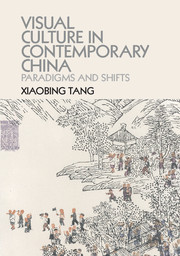Book contents
- Frontmatter
- Contents
- Acknowledgments
- A brief timeline of relevant events
- Introduction Toward a short history of visual culture in contemporary China
- Chapter 1 How was socialist visual culture created?
- Chapter 2 How was socialist visual culture created?
- Chapter 3 What do we see in New China cinema?
- Chapter 4 What does socialist visual experience mean to contemporary art?
- Chapter 5 How (not) to watch a Chinese blockbuster
- Chapter 6 Where to look for art in contemporary China
- Conclusion Seeing China from afar
- Glossary
- List of Illustrations
- Filmography
- Select bibliography
- Index
- References
Introduction - Toward a short history of visual culture in contemporary China
Published online by Cambridge University Press: 05 January 2015
- Frontmatter
- Contents
- Acknowledgments
- A brief timeline of relevant events
- Introduction Toward a short history of visual culture in contemporary China
- Chapter 1 How was socialist visual culture created?
- Chapter 2 How was socialist visual culture created?
- Chapter 3 What do we see in New China cinema?
- Chapter 4 What does socialist visual experience mean to contemporary art?
- Chapter 5 How (not) to watch a Chinese blockbuster
- Chapter 6 Where to look for art in contemporary China
- Conclusion Seeing China from afar
- Glossary
- List of Illustrations
- Filmography
- Select bibliography
- Index
- References
Summary
In this interdisciplinary study, I present and discuss artistic expressions and experiments that are pivotal to our understanding of the logic and complexity of contemporary Chinese visual culture. The six chapters take us from the mid-twentieth century to the present, covering the entire history of the People’s Republic. An array of artwork in various media and genres is examined in detail, and more is referred to. Most of these visual objects may be, and some have been, studied in academic disciplines such as art history and film studies, but I believe the notion of visual culture allows us to appreciate their significance in more interactive and more explanatory contexts. More than embodying a specific artistic imagination or conceptual innovation, these works of art take up different positions – from high to low, academic to popular, public to personal – in an evolving structure of visibility, and they contribute instrumentally, as I seek to demonstrate, to the production of a complex visual order and experience that is recognizably Chinese and contemporary. They illustrate a succession of changing practices and paradigms. What this study reveals, I hope, is the deep resonance of continuing efforts to create a distinct Chinese culture and identity in the modern era.
- Type
- Chapter
- Information
- Visual Culture in Contemporary ChinaParadigms and Shifts, pp. 1 - 17Publisher: Cambridge University PressPrint publication year: 2015



